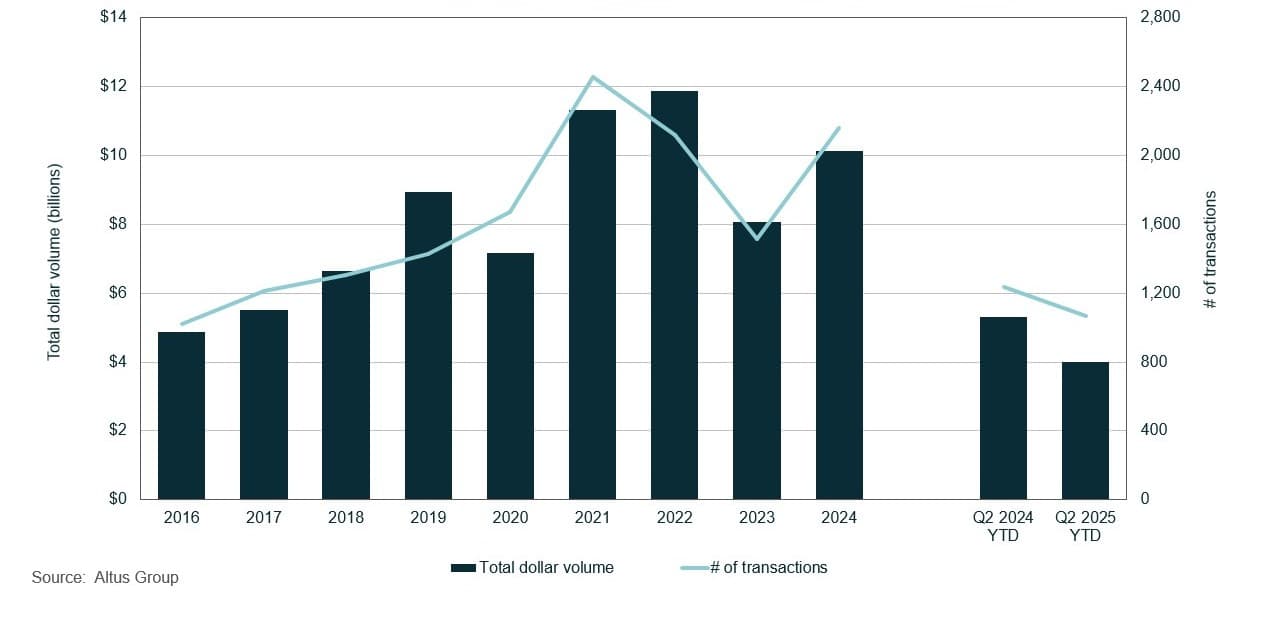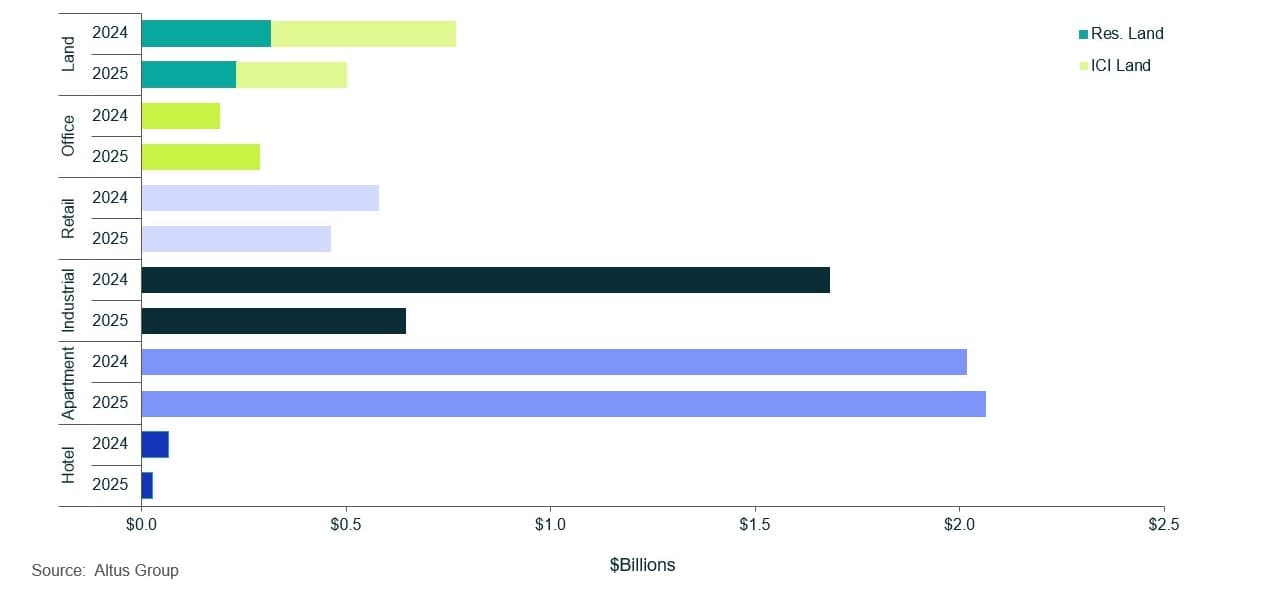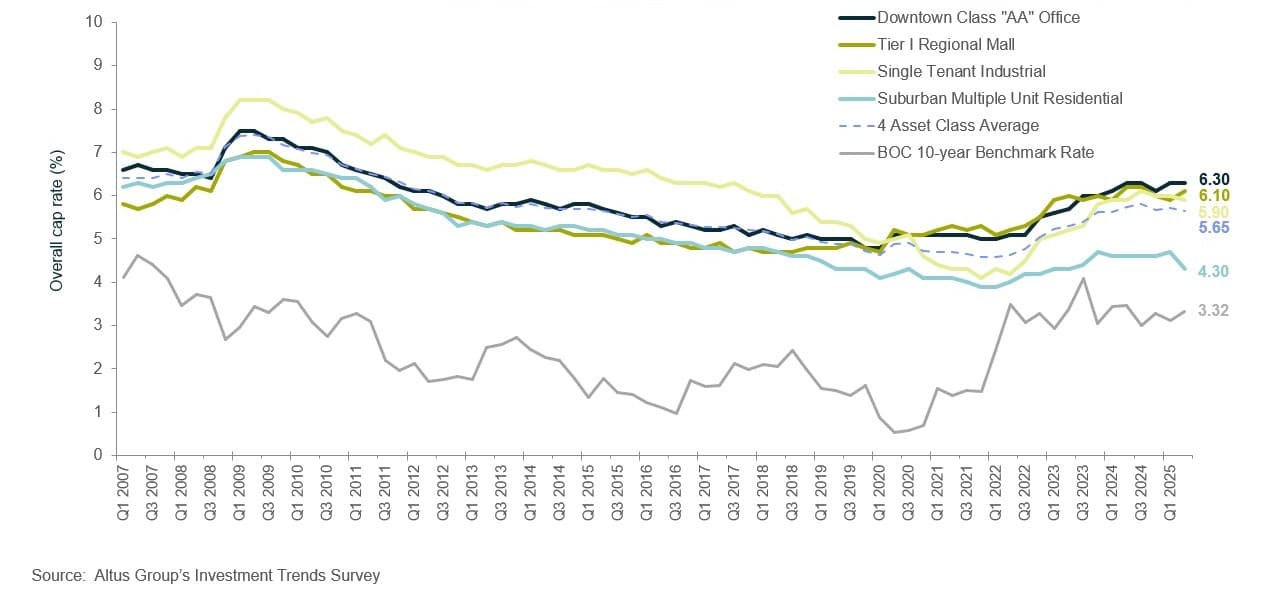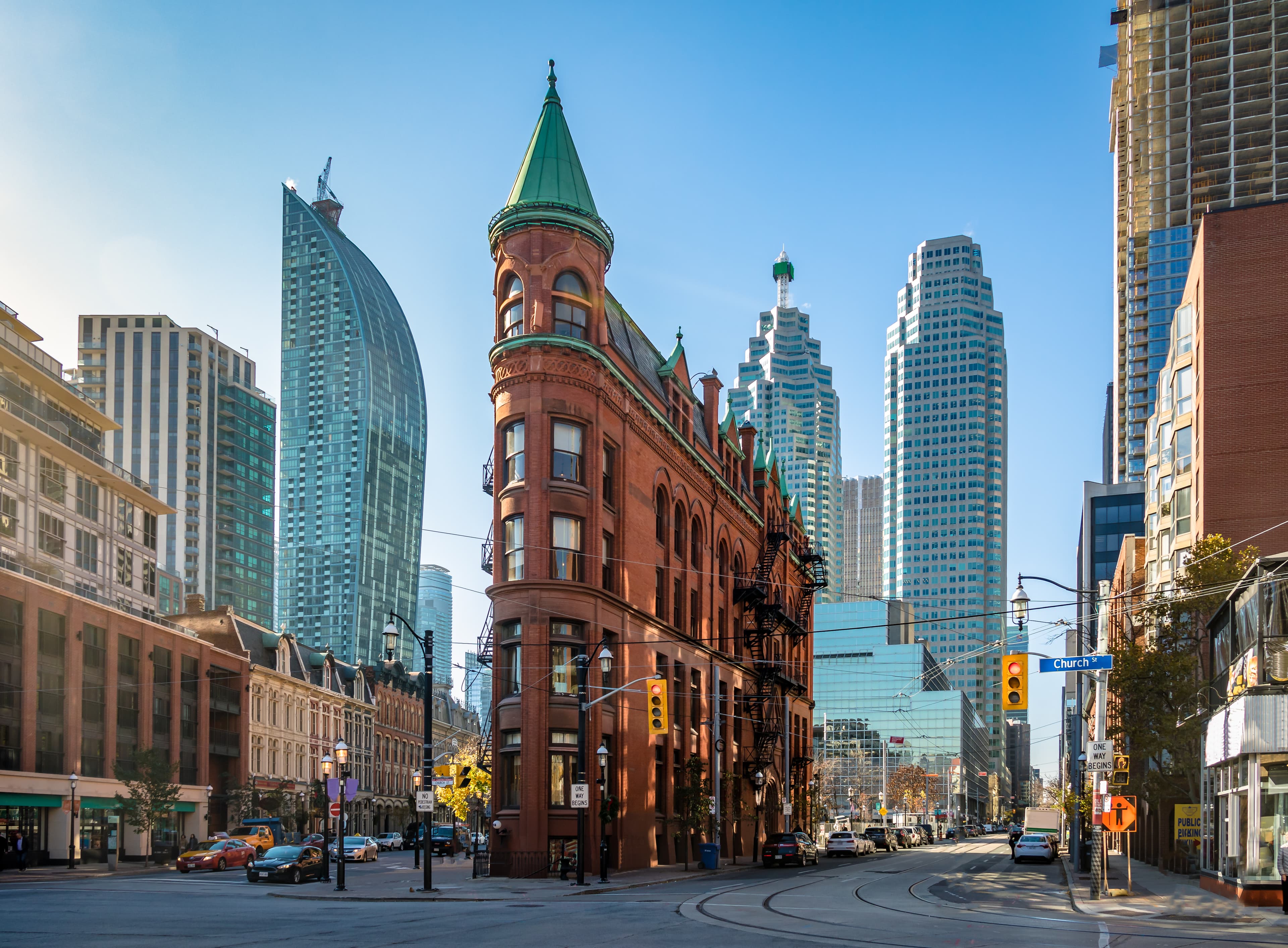Montreal commercial real estate market update - Q2 2025
Our quarterly update on Montreal’s commercial real estate market, including overall cap rates and notable property transactions across asset classes.

Key highlights:
In the first half of 2025, Montreal’s overall investment activity contracted to nearly $4 billion in dollar volume, a 25% decrease from the same period last year
The multifamily sector demonstrated relative stability, with investment volume up 2% compared to the same period last year to $2.1 billion, comprising 52% of the market’s total dollar volume transacted
The industrial sector recorded $646 million in transactions, down 62% year-over-year, as US tariffs dampened investor confidence and delayed capital deployment
The retail sector saw a slow start with $464 million in dollar volume transacted, marking a 20% decrease compared to the same period last year
The office sector recorded $290 million in transactions, a notable year-over-year increase of 51%, with activity concentrated in Class A space, reflecting a continued “flight to quality” trend
The land sector recorded $503 million in dollar volume transacted, marking a substantial 35% decrease
The residential land sector recorded $231 million in dollar volume transacted, while the ICI land sector recorded $272 million, down 27% and 40% year-over-year, respectively
In the first half of 2025, commercial investment in Montreal contracted, down 25% year-over-year
The Montreal commercial real estate market experienced a significant deceleration in investment during the first half of 2025. The total dollar volume transacted approached nearly $4 billion, which represented a substantial decrease compared to the corresponding period in the prior year (Figure 1). This apparent sharp decline in activity was largely a consequence of the proposed capital gains inclusion rate increase, which had been scheduled for implementation on June 25, 2024.
Figure 1 – Montreal property transactions – All sectors by year

The anticipation of this impending tax change had prompted investors to expedite transactions in the second quarter of 2024. Many investors had sought to finalize deals before the proposed capital gains inclusion rate increase came into effect, aiming to lock in existing, more favourable tax treatment. This proactive measure led to a substantial, albeit anomalous, surge in nationwide investment volume during that period, despite otherwise subdued market conditions. Consequently, when comparing the first half of 2025 to this artificially elevated prior-year period, the recorded 25% decline in transaction volume appeared more pronounced than it might have under normal circumstances, creating a misleading comparison to the uniquely active preceding period.
Beyond the impact of the proposed capital gains tax change, several other significant factors contributed to the subdued investment activity in Montreal during the first half of 2025. Heightened investor uncertainty played a considerable role, primarily driven by a perceived weakening of Canada’s economic outlook. This uncertainty largely stemmed from geopolitical tensions with the United States, particularly concerning the unpredictable nature of projected tariff policies from the Trump administration. The prospect of renewed trade protectionism created apprehension about committing capital to long-term real estate ventures.
In response to these economic headwinds, the Bank of Canada (BoC) maintained interest rates at 2.75% throughout the first half of 2025. While a stable interest rate environment can offer some predictability, the maintained rate, combined with a cautious economic outlook, did not stimulate the borrowing and investment activity that lower rates might have. Furthermore, shifts in immigration policy and stagnant employment growth collectively dampened the demand outlook for commercial real estate. Reduced population inflows could translate to slower growth in tenant demand across various sectors, while a sluggish labour market directly impacts office space utilization and consumer spending in retail. These cumulative factors compelled investors to adopt a more strategic and cautious approach to capital deployment, prioritizing risk mitigation over expansion.
In light of these challenging conditions, a considerable number of investors have adopted a “wait-and-see” stance, opting to defer major investment decisions until greater clarity emerged in the economic and political landscape. This deferral of capital resulted in reduced transaction volumes. Other investors strategically reallocated their portfolios, redirecting their focus towards more resilient asset classes perceived as less susceptible to market fluctuations, such as food-anchored retail properties, student housing, or retirement homes, thereby reducing investment in more volatile sectors.
Despite the challenging first half of 2025, investor sentiment for the Montreal market showed signs of recovery, according to Altus Group’s latest Investment Trends Survey (ITS). The market’s ranking in investor preference improved from last place in both the previous quarter and previous year, moving up to third-last among surveyed markets. This subtle improvement indicated an emerging shift in perception, potentially driven by the underlying stability of some asset classes and a belief that the market has hit an inflection point and has entered a recovery phase.
Retail
The first half of 2025 saw a slow start for Montreal’s retail investment sector, with a total transaction volume of $464 million. This figure represented a 20% decrease compared to the same period in the preceding year. Despite this year-over-year decline in investment volume, the market demonstrated a degree of resilience when measured against historical investment volumes, particularly amidst softened domestic economic conditions and escalating trade tensions between the US and Canada. The inherent necessity of many retail services provided a buffer against broader economic pressures.
According to Altus Group’s latest Canadian Investment Trends Survey, food-anchored retail strips were the third most popular product-market combination amongst investors. These assets continued to be highly valued for their defensive qualities, consistent consumer demand, reliable cash flow, and ability to withstand economic downturns and e-commerce pressures. Their stability and predictable performance have positioned them as a cornerstone for many investment portfolios over the past several years, offering a safe haven in an uncertain market.
A significant development poised to considerably influence shopping centres across Montreal was the nationwide closure of all Hudson’s Bay department stores. This historic departure resulted in a substantial volume of vacant anchor space in numerous Montreal shopping centres. The most notable example was the 655,000 square foot, Neo-Romanesque heritage building situated on Sainte Catherine Street West within the downtown core. The vacancy of such a large, prominent space presented both a challenge and an opportunity for urban revitalization.
With an extremely limited pool of single tenants capable of occupying such large-format units, landlords will be compelled to pursue innovative redevelopment and revitalization strategies for their properties. This situation mirrored the industry’s response to previous major anchor tenant exits, where property owners successfully reimagined and diversified their retail offerings. These strategies often integrated experiential elements, mixed-use components, or a curated selection of smaller, more specialized retailers to attract new clientele and increase foot traffic. Ultimately, the landlord’s ability to adapt swiftly and creatively was essential in alleviating the substantial impact of these vacancies and ensuring the ongoing vibrancy of these critical retail hubs.
Industrial
Observing a similar trend to most major markets across Canada, Montreal’s industrial sector experienced a contraction in dollar volume, recording $646 million. This represented a 62% year-over-year decrease, reflecting a significant shift in market conditions. Investor confidence wavered amidst a challenging economic climate, as the broader Canadian economy navigated the disruptive impact of the imposed and impending tariffs by the United States, further compounded by softening domestic economic conditions. The export-oriented nature of much industrial activity made the sector particularly sensitive to trade uncertainties.
Absorption has continued to experience negative net absorption, which can be attributed to the industrial space delivered in 2024, which has remained largely vacant in early 2025 due to weak demand.
According to Altus Group’s latest Canadian industrial market update, Montreal’s industrial availability rate increased by 40 basis points year-over-year, reaching 7.0%. This rise in availability offered tenants more options and negotiating power.
During the second quarter, Montreal added one new industrial building totalling 82,410 square feet. Notably, 100% of this newly delivered space remained available for lease, reflective of the continued pullback in pre-leasing activity and waning market demand. Looking ahead, the construction pipeline has moderated with nearly 1.6 million square feet of industrial space under construction. Of this future supply, approximately 44% was still available for lease, indicating the market could experience a slight uptick in availability rate as these projects reach completion. A potential rebound in overall industrial demand will hinge on the performance of the broader Canadian economy, including key indicators like a clearer direction regarding Canada-US trade policies, retail sales, and employment figures, all of which directly influence the need for logistics and warehousing space.
Multifamily
The multifamily sector in Montreal accounted for over half of the transaction activity in Montreal, reaching 52% of the total volume transacted in the market during the first half of 2025. This figure represented $2.1 billion in dollar volume, up 2% compared to the same period last year. Despite the flattened investment volume, Montreal’s multifamily sector performed remarkably well compared to historic values. This resilience underscored the fundamental demand for housing, even amidst broader market caution. While the condominium market has experienced an observable slowdown, attributable to an oversupply of inventory and a lack of sales, it has continued to fare better than the Toronto market, given its lower volume of inventory. This suggested that while the condominium market faced headwinds, it was not as severely impacted as in some other major Canadian cities, offering a comparative advantage.
The persistent housing affordability crisis further compounded market challenges. While this crisis generally provided long-term support for rental demand by compelling a significant portion of the population towards rental housing, the considerable volume of new condominium supply simultaneously created a more challenging environment for landlords. This eroded both the stability of rental income and the prospect of consistent capital appreciation. The confluence of heightened risk and elevated carrying costs for investors contributed to a reduction in overall investor confidence and fostered a more cautious approach to acquisitions. Consequently, market participants refocused their strategies in response to these evolving supply and demand fundamentals, with some seeking opportunities in purpose-built rental buildings with stronger demand fundamentals or smaller student and senior housing units.
Office
During the first half of 2025, Montreal’s office sector distinguished itself by demonstrating an upward trajectory in investment volume. The market recorded $290 million in dollar volume transacted, marking a notable 51% increase compared to the same period last year. This heightened activity was predominantly concentrated in Class A office space, reflecting investors’ continued preference for premium office product amidst evolving market dynamics. Class A transactions accounted for 34 deals, encompassing nearly 751,311 square feet of space. By comparison, Class B office space comprised 17 transactions, totalling approximately 361,532 square feet, underscoring a pronounced “flight to quality” trend in the market. This trend indicated a strategic pivot towards assets perceived as more resilient, offering superior amenities and being better positioned to attract and retain tenants in a competitive environment defined by hybrid work models and a desire for high-quality workspaces.
Following five consecutive quarters of negative absorption, the Montreal office sector transitioned into positive territory during the second quarter of 2025. This marked a significant milestone, representing the first positive absorption recorded since the fourth quarter of 2023. A combination of right-sizing of tenant footprints that, when coupled with limited new development, materially contributed to the market’s rebound by reducing the available supply and allowing existing vacancies to be filled. According to Altus Group’s most recent Canadian office market update, Montreal’s overall office availability rate decreased by 70 basis points year-over-year, reaching 17.6%. This decline in the availability rate highlighted a notable improvement in market health and a gradual rebalancing of supply and demand, though the rate remained elevated compared to pre-pandemic levels.
On the development front, the second quarter saw the completion of one fully leased office building, adding 39,177 square feet to the market. Looking ahead, only one office building, totalling 44,000 square feet, remained under construction. Of this future supply, 89% was available for lease, suggesting that while there was still demand for new, modern office space, it remained selective, with occupiers prioritizing prime, well-located options. The limited development pipeline was a critical factor contributing to the anticipated tightening of availability in the coming months, as less new supply would be coming online to compete with existing inventory.
Land
The land sector in Montreal, encompassing both residential and ICI land, experienced a contraction in the first half of 2025. The total transaction volume for this period reached nearly $503 million, marking a substantial 35% decrease compared to the same period in the preceding year. This downturn indicated a more cautious investment climate and reduced development activity across the region, reflecting the broader economic uncertainties and higher borrowing costs.
A closer analysis revealed that the ICI land sector accounted for the largest share of this downturn, with transaction volumes totalling nearly $272 million. This represented a significant 40% year-over-year decrease, reflecting a slowdown in commercial and industrial development plans. Developers were likely delaying new projects given the softening demand in those sectors and the higher cost of capital. Similarly, the residential land sector also experienced a notable decline, reporting $231 million in dollar volume transacted, a 27% decrease year-over-year. This suggested that despite ongoing housing demand, developers adopted a more reserved approach to acquiring land for new residential projects, likely influenced by elevated construction costs, interest rate uncertainties, and a re-evaluation of market absorption rates, particularly for larger-scale condominium developments. The overall contraction in land transactions pointed to a period of adjustments as developers and investors assessed evolving economic conditions and market fundamentals, taking a more conservative stance on future development.
This contraction in the construction pipeline could carry long-term implications. It may exacerbate the broader housing supply shortages by limiting the creation of new residential units, driving up prices and rents in the future as demand outstrips supply. It could also hinder long-term economic growth by limiting commercial and industrial expansion, as businesses may struggle to find suitable new spaces for growth. Consequently, the market may see an increase in reliance on the redevelopment and adaptive reuse of existing properties, extending the lifecycle of older structures and transforming them into vibrant mixed-use spaces. This approach can be more cost-effective and sustainable, utilizing existing infrastructure. Investors are expected to maintain a cautious approach, favouring stable assets over speculative land development until market fundamentals offer clearer returns and more favourable conditions for new construction.
Figure 2 - Montreal property transactions - All sectors by year

Notable transactions for Q2 2025
The following are the notable transactions for the Q2 2025 Montreal commercial real estate market update:
1200 McGill College, Ville-Marie - Office
The highest value transaction in Montreal for the second quarter was the nearly $101 million sale of 1200 McGill College. KingSett Capital acquired the 24-storey office tower from BUSAC Immobilier, a subsidiary of New York-based JEMB Realty. Constructed in 1976, the main tower boasts approximately 240,000 square feet of office space and is complemented by a 73,000 square foot retail podium featuring a 1929-built façade that fronts onto Sainte-Catherine Street West. During the second quarter, KingSett also disposed of an additional eight properties for nearly $66 million, which are located across the Montreal and Toronto markets.
Méga Centre Notre-Dame, Laval - ICI Land
In April, Rosefellow acquired a 27-acre portion of the Méga Centre Notre-Dame retail plaza in Laval from Harden and RioCan for $75 million. The property is improved with seven single-storey retail buildings containing a total of 263,847 square feet of space. Immediately after the date of sale, Rosefellow actively marketed redevelopment plans featuring 550,000 square feet across three industrial buildings, with 40-foot clear heights. This planned redevelopment represented a price per acre of $2.7 million and a price per square foot buildable of $136.
5600 Sherbrooke Street East, Mercier-Hochelaga-Maisonneuve - Residential Land
Groupe HD and Fondaction acquired this 212,000 square foot vacant parcel in Montreal’s Mercier-Hochelaga-Maisonneuve borough for $57 million. Located only 200 metres from the L’Assomption metro station, the buyers intended to develop the property into two, twelve-storey residential buildings. The proposed development would contain a total of 1,200 units, including approximately 180 affordable housing units. The Mercier-Hochelaga-Maisonneuve borough is also home to Rachel Julien’s 928-unit Canoë project, a residential development located at 4500 Hochelaga Street, the first two phases of which are anticipated to reach completion during summer 2025.
1200 Mackay Street, Ville-Marie - Apartment
Montreal-based developer Mondev sold its latest completed project, an eleven-storey, 125-unit high-rise, to institutional investor Canadian Urban. Valued at a price per unit of $440,000, the building primarily contained studio and one-bedroom apartments, with a fitness centre and rooftop terrace as amenity spaces. Completed prior to the end of 2024, this sale occurred within one year of completion and marked Mondev’s fifth project to be completed and sold within the past year. The five buildings contained a total of 728 units and were sold for an aggregate total of $306 million.
Place Laval, Laval - Office
In two separate transactions, Cominar sold the 853,000 square foot Place Laval office complex for a combined $72 million. The first transaction involved the sale of the existing five office towers to Poirier for $54 million. The second transaction pertained to approximately 465,000 square feet of extra land on the southwest side of the property, which was acquired by Oktodev for $18 million. Cominar has divested approximately 1.83 million square feet of office space since the start of 2024.
Figure 3 - Montreal OCR trends across 4 benchmark asset classes

Looking ahead
The first half of 2025 presented a challenging landscape for Montreal’s commercial real estate market, marked by a significant downturn in overall investment volume. The lingering effects of the anticipated tax changes, coupled with heightened economic and geopolitical uncertainties, compelled investors to adopt a cautious “wait-and-see” approach. While most sectors experienced contractions in investment, the multi-family market demonstrated notable resilience, and the office sector showed early signs of a positive trajectory, driven by a “flight to quality” trend and improving absorption.
Looking ahead, Montreal appears poised for a gradual and measured recovery in the second half of 2025. Investors' sentiment, while still cautious, is showing nascent signs of improvement, as evidenced by Montreal’s improved ranking in recent surveys. The stability of interest rates, maintained by the BoC, is expected to provide a degree of predictability, potentially encouraging more active participation.
The remainder of the year will likely see a continued emphasis on strategic recalibration and risk mitigation across all sectors. Investors are expected to favour asset quality and proven revenue streams, reinforcing trends such as the “flight to quality” observed in the office and industrial markets, as well as the resilience of food-anchored retail properties. The constrained development pipelines across several sectors suggest a future tightening of supply, which could lead to price stabilization or even increases once demand fully recovers, and economic clarity emerges. This environment is likely to encourage the adaptive reuse and redevelopment of existing properties as a more viable strategy. Ultimately, Montreal’s inherent economic strengths and the proven adaptability of its real estate stakeholders position the market to gradually regain momentum, with selective opportunities emerging for those investors who skillfully navigate the evolving landscape.
Want to be notified of our new and relevant CRE content, articles and events?
Authors

Jennifer Nhieu
Senior Research Analyst

Stephen Robinson
Team Lead, Market Research
Authors

Jennifer Nhieu
Senior Research Analyst

Stephen Robinson
Team Lead, Market Research
Resources
Latest insights





